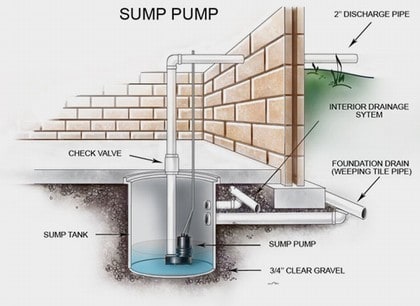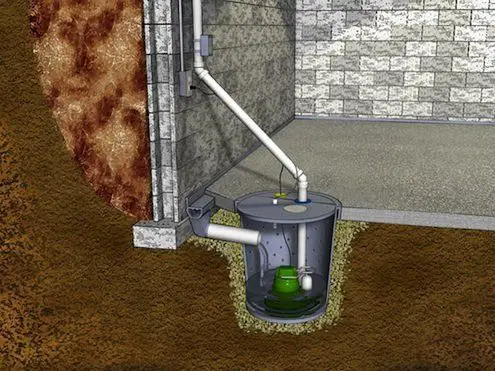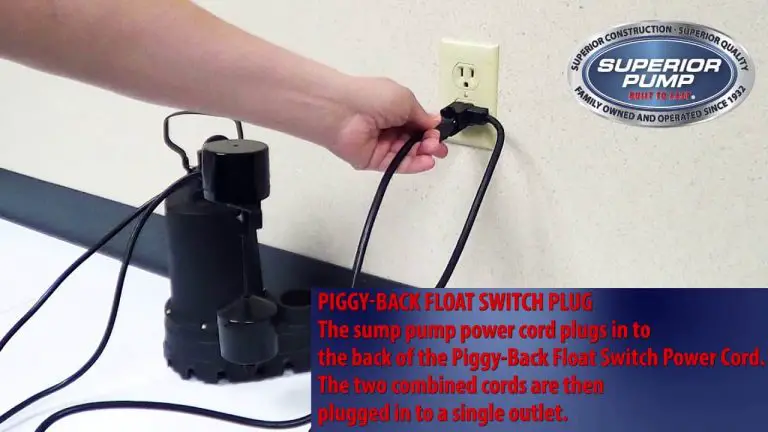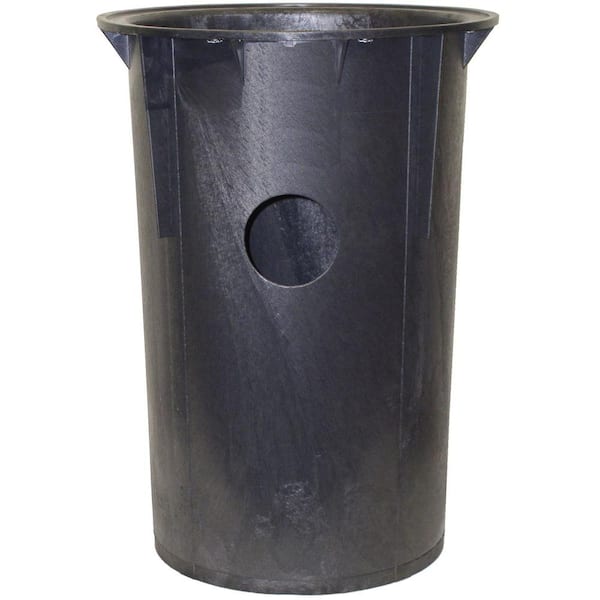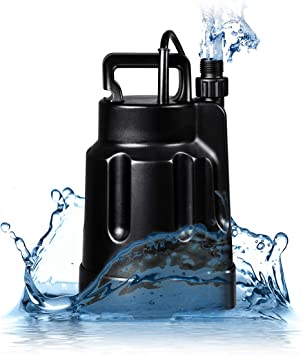Is It a Code Violation for a Sump Pump to Drain in a Sewage Pit
A sump pump is a device that is used to remove water that has accumulated in a water-collecting sump pit. The water is typically pumped out of the pit and away from the building. However, if the sump pump drains into a sewage pit, it may be considered a code violation.
If you have a sump pump in your home, you may be wondering if it’s against code to have it drain into a sewage pit. The answer is that it depends on the municipality in which you live. Some codes allow for this, while others do not.
In general, however, it is advisable to have your sump pump drain into a storm sewer or other approved drainage system rather than into a sewage pit. This will help keep your home and its surrounding area free of potential flooding and contamination.
Sump Pump Discharge Line Failure and Fix
Sump Pump Discharge Code
If your home is equipped with a sump pump, it’s important to know the ins and outs of proper maintenance. Part of that is understanding sump pump discharge code, which can vary depending on where you live. In this blog post, we’ll give you a rundown of everything you need to know about sump pump discharge code, including what type of pipe to use and how to direct the water away from your home.
Sump pumps are installed in basements or crawlspaces to help remove excess water from these areas. The water is typically pumped out through a pipe that runs from the sump pit to an area outside the home where it can safely drain away. Sump pump discharge code typically dictates what type of pipe should be used for this purpose, as well as how the water should be directed away from the home.
PVC pipe is usually the best choice for sump pump discharge lines because it’s inexpensive and easy to work with. However, some local codes may require that another type of material be used, such as ABS or cast iron. Be sure to check with your local building department before purchasing any materials.
Once you have the correct materials, follow these tips for properly installing a sump pump discharge line:
1) Run the pipe downhill from the sump pit so that gravity can help move the water through it. If necessary, use elbow joints or other fittings to make turns in the line.
2) Connect the pipe to an outlet that allows water to drain away from your home without causing any damage or flooding. This could include a dry well, French drain, catch basin, etc.
3) Make sure that all connections are sealed tightly so that no water can leak out (this could cause serious structural damage).
Use Teflon tape or silicone caulk around all threaded connections.
4) Cover any exposed sections of piping with insulation foam tubing (this will help prevent freezing in winter).
By following these simple tips, you can ensure that your sump pump discharge line is installed correctly and up to code!
Sewage Ejector Pump
If you have a home with a basement, chances are you have a sewage ejector pump. This type of pump is responsible for pumping wastewater out of your home and into the city sewer system. Without it, your home would quickly become unlivable due to the buildup of sewage.
While most homes have a sewage ejector pump, many people don’t know much about them. Here are some things you should know about your sewage ejector pump:
1. It’s important to keep the area around your sewage ejector pump clean.
This will help prevent clogs and other problems.
2. Your sewage ejector pump should be inspected annually by a professional plumber. This will help ensure that it’s in good working order and can catch any problems before they become serious.
3. If your sewage ejector pump does stop working, it’s important to call a professional plumber right away. Attempting to fix the problem yourself could make it worse and put your family at risk for exposure to raw sewage.
4. Sewage ejector pumps require electricity to operate, so during a power outage you’ll need to use an alternate method for disposing of waste water (such as a portable toilet).
Sump Pumps
A sump pump is a device that is installed in the basement of a home. Its purpose is to remove water that has accumulated in the sump pit and to prevent flooding. Sump pumps are used in homes that are built on slabs or have crawl spaces.
They are also used in homes that have basements but no floor drains.
Sump pumps come in two basic types: submersible and pedestal. Submersible sump pumps are designed to be placed inside the sump pit, while pedestal sump pumps are designed to be placed outside of the pit.
Both types of sump pumps work by drawing water from the pit and then pumping it out of the home through a discharge pipe.
Most sump pumps are powered by electricity, but there are also battery-powered and hand-operated models available. Battery-powered sump pumps can provide backup protection during power outages, while hand-operated models can be used if there is no electricity available.
SUMP PUMP BENEFITS:
1) Prevents Basement Flooding – A wet basement is not only inconvenient, it’s also a health hazard due to mold and mildew growth. A sump pump protects your basement by quickly removing any water that accumulates before it has a chance to cause damage or create unhealthy conditions.
2) Reduces Humidity – In addition to preventing flooding, a properly functioning sump pump will also help reduce humidity levels in your basement by removing excess moisture from the air. This can create a more comfortable living environment as well as help prevent wood rot and other damage caused by high humidity levels.
3) Protects Your Foundation – Water seepage can weaken your foundation over time leading to cracks and even collapse if left unchecked.
Sump Pump Basin
A sump pump basin is a container that is used to collect water. This water is then pumped out of the basin and away from the foundation of your home. A sump pump basin is typically installed in homes that are located in areas where there is a high water table or where flooding is common.
The size of the sump pump basin will vary based on the size of your home and the level of rainfall in your area. It is important to choose a size that will be large enough to handle the amount of water that you expect to collect. The basin should also be made from durable materials that can withstand years of exposure to moisture and humidity.
Installing a sump pump basin is not a difficult task, but it is important to follow all instructions carefully. In most cases, the basin can be placed directly onto your existing basement floor. Once the basin has been installed, you will need to connect it to a power source and an outlet so that it can be used when needed.
Grinder Pump
If you have a home in a rural area, chances are you have a grinder pump. A grinder pump is used to grind and/or move sewage from your home to an underground septic tank or sewer system. This type of pump is typically used when homes are not connected to a municipal sewer system and must dispose of their wastewater themselves.
Grinder pumps are usually located in the basement or crawlspace of your home, and consist of two parts: the grinding unit and the motor. The grinding unit contains rotating blades that chop up sewage as it passes through, while the motor powers the blades and moves sewage through the pump. Grinder pumps typically run on electricity, but there are also some models that can be powered by a gasoline generator in case of a power outage.
While having a grinder pump is not required by law, most homes in rural areas cannot connect to a municipal sewer system without one. If you live in such an area and do not have a grinder pump, you will likely need to install one before connecting to a sewer system.

Credit: diy.stackexchange.com
Can I Discharge My Sump Pump into the Sewer?
Most sump pumps are designed to discharge water away from your home. However, in some instances, you may be able to discharge your sump pump into the sewer.
Before doing so, check with your local municipality to see if it’s allowed.
There may be certain restrictions in place, such as only being able to discharge during certain hours or only being able to do so if your pump is equipped with a backflow prevention device.
If you are able to discharge into the sewer, be sure to keep an eye on the water level in the sump pit. You don’t want it to get too low, as this could cause your pump to run dry and overheat.
Additionally, make sure that any debris that gets pumped into the sewer doesn’t clog up the system.
Where Should Basement Sump Pump Discharge To?
A sump pump is a device that is installed in the lowest part of a basement or crawlspace to remove any accumulated water. Sump pumps typically have a pit or basin that collects the water before it is pumped out of the space and away from the foundation. Most homes will have their sump pump discharge pipe routed to an existing drainage system, such as a storm sewer or dry well.
In some cases, however, it may be necessary to discharge the water onto your lawn or other area where it can safely drain away without causing any damage.
When deciding where to route your sump pump discharge, there are a few things you need to take into consideration. First, you need to make sure that the discharge pipe is large enough to handle the volume of water that will be flowing through it.
A 1/2″ pipe is typically sufficient for most homes, but if you have a particularly high water table or are expecting heavy rains, you may need a larger pipe. Second, you need to make sure that the outlet for your discharge pipe is located at least 10 feet from your foundation so that any potential flooding will not cause damage to your home. Finally, you should check with your local building code office to see if there are any specific requirements for sump pump discharge in your area.
If you’re not sure where to route your sump pump discharge, feel free to contact a professional plumber for help. They will be able to assess your situation and advise you on the best way to keep your basement dry and free of any unwanted water accumulation.
What is the Code for Sump Pumps?
A sump pump is a device that is used to remove water that has accumulated in a water-collecting sump basin, typically found in the basement of homes. The water is typically pumped out of the sump basin through a hose or pipe to another location where it can be safely discharged, such as into a storm sewer or natural body of water.
Sump pumps are used to protect homes from flooding and can be either pedestal or submersible type pumps.
Pedestal sump pumps have an electric motor that is mounted on a vertical stand above the floor level, while submersible sump pumps are designed to sit inside the sump pit itself.
There is no specific code for sump pumps, but they must meet the standards set by the National Sanitation Foundation (NSF). NSF/ANSI Standard 50 covers submersible sewage effluent pumps and sewage grinder pumps used in residential, commercial, and institutional applications.
Where Does a Sump Pump Drain Too?
If your home is built on a slab, the sump pump will likely drain to an exterior French drain or dry well. If your basement has a floor drain, the sump pump may be connected to that. Some homes have a laundry tub in the basement that can be used for this purpose.
In any case, it’s important that the water be discharged at least 10 feet away from the foundation of your home to avoid flooding.
Conclusion
A lot of people have their sump pumps draining into sewage pits, but they don’t realize that this is actually a code violation. The reason for this is because the sewage pit can fill up with water and then start to overflow, which can cause all sorts of problems. If you have a sump pump, you need to make sure that it’s draining into a proper drainage system so that you don’t have any issues down the road.

